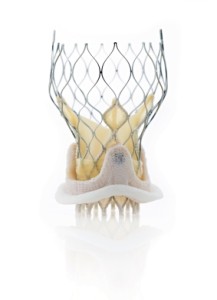 Medtronic, Inc. has received CE Mark approval for valve-in-valve (VIV) procedures using the CoreValve® and CoreValve® Evolut™ transcatheter aortic valve implantation (TAVI) systems in degenerated bioprosthetic surgical aortic valves.
Medtronic, Inc. has received CE Mark approval for valve-in-valve (VIV) procedures using the CoreValve® and CoreValve® Evolut™ transcatheter aortic valve implantation (TAVI) systems in degenerated bioprosthetic surgical aortic valves.
Background
Each year, approximately 200,000 people worldwide receive surgical aortic valves, which typically last 15 years or more. When the surgical valves degenerate due to the aging process, patients require another valve replacement. However, some patients are not eligible for a second open-heart surgery, and the transcatheter VIV procedure now may provide them with a new treatment option.
The valve-in-valve procedure, in which the CoreValve System is placed inside the degenerated surgical aortic valve through a low-profile, 18Fr delivery catheter, is approved for use with all four CoreValve sizes (23mm, 26mm, 29mm and 31mm), as well as three delivery approaches (transfemoral, subclavian and direct aortic access).
This is the first ever regulatory approval for VIV procedures, which provide a minimally invasive treatment option for patients whose surgical aortic valves have degenerated, and who are at extreme or high risk for surgery and would otherwise go untreated.
Results from the largest global VIV registry, published in Circulation in November (Transcatheter Aortic Valve Replacement for Degenerative Bioprosthetic Surgical Valves: Results from the Global Valve-in-Valve Registry), showed the VIV approach resulted in considerable hemodynamic (blood flow) improvements, including a decrease in valve gradients (blood flow resistance). Positive procedural outcomes were maintained at 1-year follow-up (with 89 percent survival at one year), which was comparable with other non-VIV TAVI studies.
Physician comments
“While surgical valves provide effective therapy for many patients, the replacement valves eventually degenerate over time, so valve-in-valve has become a topic of great clinical interest due to the needs of these patients,” said Ran Kornowski, M.D., chair of cardiology at Rabin Medical Center and Tel-Aviv University in Tel-Aviv, Israel, and previously at Washington Hospital Center in Washington, D.C., and senior author of the Global Valve-in-Valve Registry. “European approval of the CoreValve procedure is a very important advance in the treatment of severe aortic stenosis and enables an entirely new group of patients to benefit from this transcatheter valve.”
Company comments
“We are pleased to now extend this safe and less-invasive, valve-in-valve procedure. This approach allows patients to avoid a second open-heart surgery to replace a failing surgical valve, which was originally performed to replace their own diseased valve.” said John Liddicoat, M.D., senior vice president, Medtronic, and president of the Medtronic Structural Heart Business. “Furthermore, the impressive improvements in hemodynamic performance, due to CoreValve’s supra-annular design, are showcased in the results of these valve-in-valve procedures.”
Regulatory status
The Medtronic CoreValve System is available in the United States for investigational use only. In the Medtronic CoreValve U.S. Expanded Use Study, the U.S. FDA has approved investigational VIV procedures in extreme-risk patients (part of the pivotal trial evaluating the CoreValve System in the U.S.).
Source: Medtronic, Inc.





